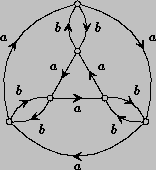What is Geometric Group Theory?
A simple definition of Geometric group theory is that
it is the study of groups as geometric objects.
Thinking about groups this way was popularized by Gromov
who revolutionized the subject of infinite groups. This is a new field,
so there are many fundamental theorems waiting to be discovered, and it
is a rich field, lying at a juncture between algebra and topology, where
a great variety of methods from other branches of mathematics can be utilized.
Geometric group theory draws upon techniques from, and solves problems
in the theory of 3-manifolds, hyperbolic geometry, combinatorial group
theory, Lie groups...
The simplest way of regarding a group as a geometric object
is through its "Cayley Graph".
Consider a finitely generated group G with generators
s1,
s2, ... , sn.
This just means that every element of
G can be expressed as a product
of the si elements and their inverses. The Cayley
graph of G
is a graph whose vertices are precisely the elements
of G, and whose edges are described by the rule that for each
pair of elements x, y of G there is an edge labeled by
the generator si which originates at x and terminates
at y provided that
xsi
= y .
 An
elementary example is the Cayley graph of the dihedral group D3,
which is the group of symmetries of an equilateral triangle. Of course,
the Cayley graph depends on the choice of generators. In this case we are
using a generator a which is a 120 degree rotation, and a generator
b
which is a reflection.
An
elementary example is the Cayley graph of the dihedral group D3,
which is the group of symmetries of an equilateral triangle. Of course,
the Cayley graph depends on the choice of generators. In this case we are
using a generator a which is a 120 degree rotation, and a generator
b
which is a reflection.
When the group G is infinite, its Cayley graph
reflects large-scale geometric features which can have a profound effect
on the algebra of G. Techniques which are reminiscent of topology
and Reimannian geometry can be brought to bear, and they can reveal deep
properties of the group which are hidden to combinatorial and algebraic
investigation.
 An
elementary example is the Cayley graph of the dihedral group D3,
which is the group of symmetries of an equilateral triangle. Of course,
the Cayley graph depends on the choice of generators. In this case we are
using a generator a which is a 120 degree rotation, and a generator
b
which is a reflection.
An
elementary example is the Cayley graph of the dihedral group D3,
which is the group of symmetries of an equilateral triangle. Of course,
the Cayley graph depends on the choice of generators. In this case we are
using a generator a which is a 120 degree rotation, and a generator
b
which is a reflection.